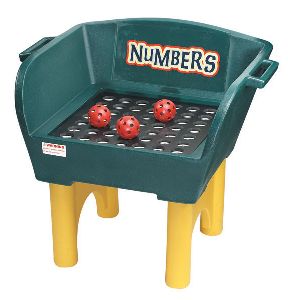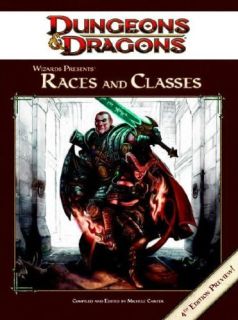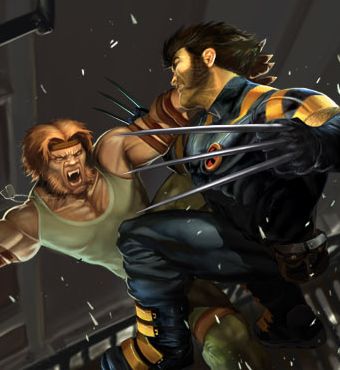I’ve been playing Resistance 2 lately, taking in its new cooperative mode on the recommendation of a couple of friends. Co-op in shooters has a long but spotty tradition, so it was neat to see Insomniac deliver a non-competitive experience with a different feel. This one gives the player one of three classes that can be leveled up independently by matching up to play short missions. Each class has a different loadout and responsibility when played: grunt, medic, supply. In addition, there is a resource that can be gathered during matches in order to purchase upgraded abilities and weapon packages.
It was a fairly addicting experience, as I pushed to each successive level like I might grind an MMO. The matches themselves were entertaining on their own, with tangible sense of achievement every few rounds. Unfortunately, I eventually ran out of gas, not because the game itself wasn’t fun enough… but rather because each creature had 5-10 times the health of their single-player counterparts. The campaign was a well-balanced shooter with crisp control aim and a great sense of power, but coop had me holding my machinegun on what should have been “popcorn” enemies for several seconds, watching XP pile up as I waited for each bag of hit points to fall down. Quite simply, it didn’t feel at all like the shooter than I played when not online.
I cannot fault the concept of jacking up the time to kill each enemy… it’s a time-honored tradition from many classic games. In Resistance 2, it was clear that they needed to extend the experience and increase the effort required to bring each one down.  It’s probably a useful excercise to discuss why this might be.
The Numbers Game
One reason for enemies to soak up bullets in coop is to match the level of difficulty to the number of players. If 10 players entered a level that was intended for just one, they would slaughter everything with their added firepower. Some games ship this way, whether due to limited resources or to reward the effort that used to be involved to connect multiple PC’s for a coop session in the first place.  These days most do their best to notch up the challenge when new players join a session, and sometimes this is done by increasing the enemy toughness.   Diablo did this in the most overt fashion, by reporting to the player that “the enemy forces have grown stronger” when each additional player joins the game. Behind the scenes it was increasing the experience level equivalent of all the enemies in the world.
Another reason for enemies feeling more invulnerable are in games with a progression track… ones that reward the player for each hour of play with upgrades in ability and potency (like Resistance 2 does). Unfortunately it’s easy to forget that in order to build a game where the player feels more powerful over time, you must hold back some of the most potent player abilities at the start of the game. The player certainly feels a sense of achievement as he gains all the new kick-ass stuff over the course of the game, but sometimes that means he also feels anemic at the very beginning, where he has the least capability. The damage potential for his weapons are less, his health is less. His weapons aren’t as flamboyant. Even the most basic enemies might take far longer to kill than they will later on. This is a dangerous practice that must be handled with care… these are the crucial early hours where a player should be falling in love with the product rather than feeling emasculated.
 Somehow this is an acceptable practice in RPG’s… Those games are almost entirely about progression and acquisition, so it is expected that the player will evolve tremendously over hundreds of play hours (or thousands in an MMO). But because of these incredible progression arcs, most RPG’s play what I call The Numbers Game. You’ve doubtless seen it… when players start off their game doing tiny amounts of damage to wimpy rats, but eventually grow to deal thousands of points while fighting giant dragons. In these situations there is a continual arms race between the damage you deal and the health of your enemies.
Somehow this is an acceptable practice in RPG’s… Those games are almost entirely about progression and acquisition, so it is expected that the player will evolve tremendously over hundreds of play hours (or thousands in an MMO). But because of these incredible progression arcs, most RPG’s play what I call The Numbers Game. You’ve doubtless seen it… when players start off their game doing tiny amounts of damage to wimpy rats, but eventually grow to deal thousands of points while fighting giant dragons. In these situations there is a continual arms race between the damage you deal and the health of your enemies.
For example:  I’m playing an MMO and start with a character who can deal an average of 20 points of damage to an enemy who has about 100 health. About 5 hits will take him down.  After some play time, I level my character to level 20, and can now deal 100 points of damage. Good for me! …except now most of the enemies have around 500 health. I guess it’s still 5 hits to kill one. Finally, after months of investment I reach the coveted level 50, and I’m clobbering opponents with 1000 points per hit. Of course, you guessed it, my enemies have 5000 HP (or more).
This shouldn’t be a big surprise, because as you gain power, it would be anticlimactic to see a lessening difficulty… we all want to grow up to finally beat that huge, scary thing that we fled from many hours of play ago. Keep in mind what this means, however: In a combat-centric game, a player’s primary metric of power is the number of hits per kill. (This abstracts to “the ratio of time investment per reward”… but that’s fodder for a later post).  But when I play the Numbers Game, do I really feel better about taking down a Level 50 Hoary Drake with my Level 50 character than I did taking down the Level 1 Scrawny Rat with my Noob? The answer in RPG’s is often “yes”, but in shooters you can get in a lot more trouble.
The difference is in the essences of the genres… RPG’s deal with skill advancement primarily on the character itself, as he “levels up” and increases his capability through higher numerical stats.  The player himself has less pressure to hone his actual playing skill, aside from juggling the new options presented to him when new abilities are unlocked.  He makes choices about how he wishes to advance, working with figures like “strength”, “speed” and “willpower”, even though they often just present different ways of hurting an enemy. These various axes of advancement give the player something to aim for, a vast possibility space that he can explore and achieve in.
Since advancement is so tied to how the player’s capabilities are represented, the player keeps a much greater awareness of the numbers and how they affect him. He understands and accepts that an enemy that is 5 levels above him is extremely dangerous, because the numbers say so. This is totally fine, because most RPG’s are not about combat… they’re about advancement, acquisition, and a bit of exploration.  (If you really believe that you played Diablo for the click-and-kill combat, I think I have some real estate you might be interested in…)
Shooters by comparison leave skill advancement largely to the player’s mind and body. Your manual aiming ability is your primary “accuracy stat”, and timing, dodging and area management are all critical traits that don’t live in the game itself.  In most shooters the player’s character is just as effective with a pistol at the beginning of the game as he is at the end… even though the game progressively demands more of the player himself with larger groups of foes and challenging level layouts.
Shooters also are tuned for action experience, living and dying by their weapon balance and ammunition management… Killing one enemy is usually 1-3 shots, and an FPS starts to instinctively know which weapon is best for each situation.  This is the biggest reason that shooters are so seriously wounded by the Numbers Game. By increasing enemy health arbitrarily, the choice of weapon eventually becomes less important. Enemies that used to be demolished by a shotgun blast take several hits, causing players to switch from surprise or flanking maneuvers to attrition tactics. Pistols go from being the standby for taking out weak enemies with minimal ammo investment to becoming basically useless. Different skills and sometimes abhorrent tactics are adopted in order to succeed because the game becomes increasingly “unfair”. Players might even start to think in terms of DPS (Damage per Second), a major metric in MMO’s and a strong symptom of the Numbers Game.
More Than Just Digits
So this argument does nothing to help out the intrepid FPS designer, who still needs to solve these difficulty issues… He’s willing to do anything to make the game as fun for 10 players as it is for one, and to make gamers feel increasingly awesome for each hour he plays. I don’t blame folks for falling back on the numbers when they need to; Diablo II is still my favorite game of all time, and when working X-Men Legends I personally applied the Numbers Game to near-excess (more on that another day).
Solving this problem through other means is really hard, but going the Bags o’ HP route should be a last resort. I’ll see if I can scrape up some alternatives in the next post.


 If you are someone who follows game design (and if not, what are you doing here?), you should consider looking at the
If you are someone who follows game design (and if not, what are you doing here?), you should consider looking at the  In low-levels, you have very little hit points that cause you to rather easily perish… This makes it extremely challenging for a DM to challenge the group without risking that one of them will just fall over dead on a bad run of die rolls. Plus first-level characters just don’t have any options other than “blast the thingâ€.
In low-levels, you have very little hit points that cause you to rather easily perish… This makes it extremely challenging for a DM to challenge the group without risking that one of them will just fall over dead on a bad run of die rolls. Plus first-level characters just don’t have any options other than “blast the thingâ€. A bit of history on this, I wrote it while I was in the midst of a job search. They had asked for an analysis of this sort for one of several games, including my fave,
A bit of history on this, I wrote it while I was in the midst of a job search. They had asked for an analysis of this sort for one of several games, including my fave,  In the case of X-Men, there were a few things that dawned on me too late to really get into the design. The first was a smaller realization… For a good chunk of development we were looking for solid gameplay elements that took advantage of the various forms of elemental attacks that the X-Men used… Typically it was difficult because it was custom-scripted, and generally required one specific hero at the expense of all others in order to enact, which went up against our credo of letting the player choose their favorite X-Men and focus on them. However, after
In the case of X-Men, there were a few things that dawned on me too late to really get into the design. The first was a smaller realization… For a good chunk of development we were looking for solid gameplay elements that took advantage of the various forms of elemental attacks that the X-Men used… Typically it was difficult because it was custom-scripted, and generally required one specific hero at the expense of all others in order to enact, which went up against our credo of letting the player choose their favorite X-Men and focus on them. However, after